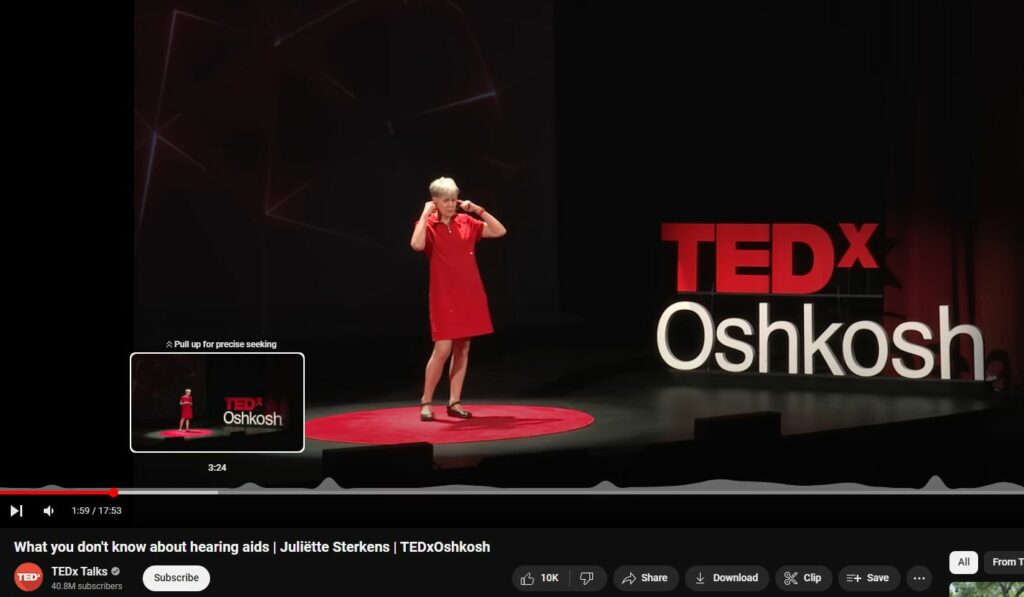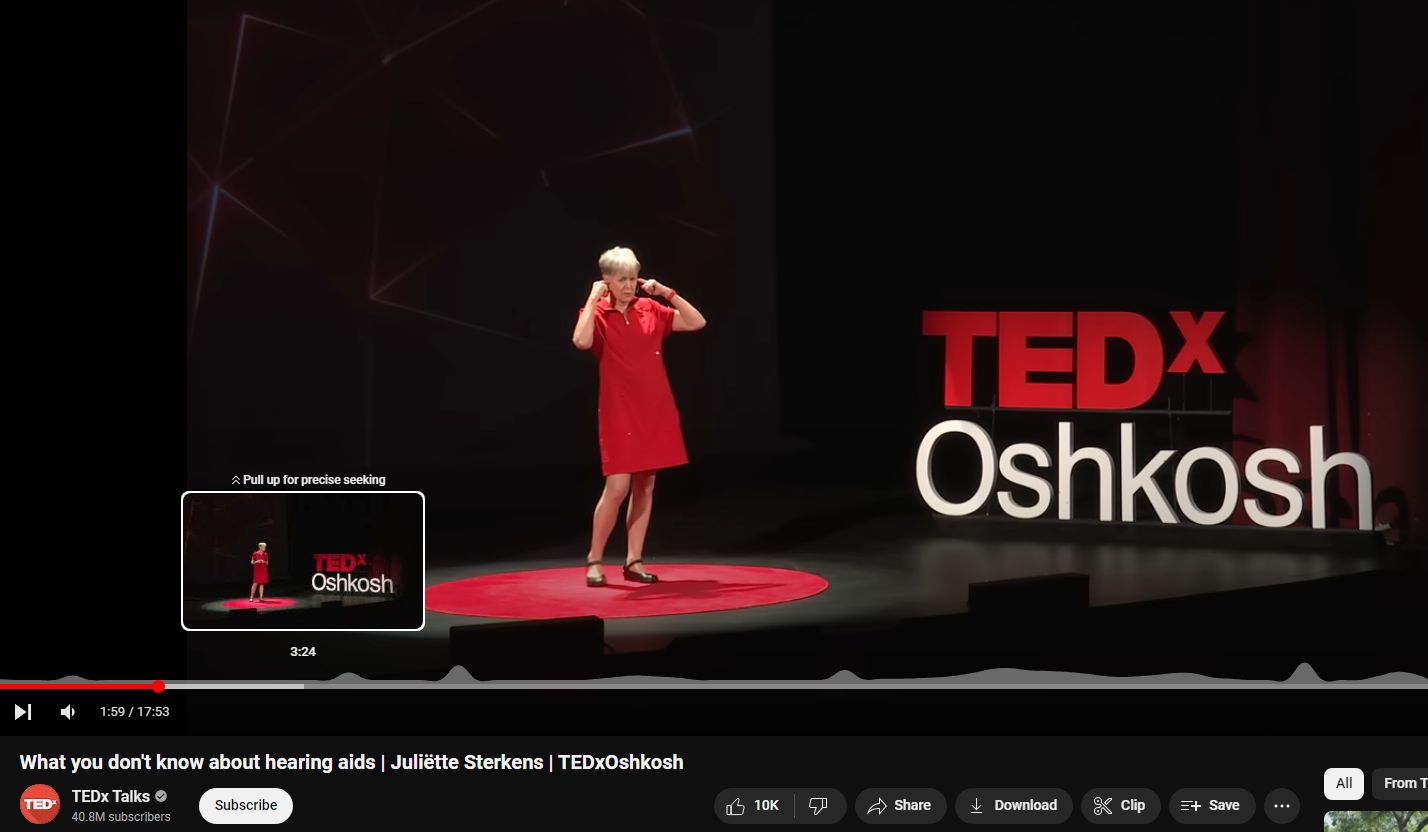Hearing Aids amplify but do not necessarily clarify
What you don’t know about hearing aids | Juliëtte Sterkens | TEDxOshkosh
Mar 2, 2024
https://www.youtube.com/watch?v=0vf1q_HgLpw
For most people it’s not a matter of if, but when, they will lose some sense of hearing. Still, we don’t give hearing loss or hearing aids much thought until it happens to us–or someone we know. Only then do we learn that hearing aids are incapable of restoring hearing to normal, especially in acoustically challenging situations. The good news is that modern technology continues to bring us new, sometimes hidden, and often unknown features that can help those with hearing loss overcome more of their hearing challenges.
Juliëtte Sterkens, AuD, is an audiologist with forty years of experience in hearing rehabilitation turned consumer advocate with the Hearing Loss Association of America. She has published numerous articles and lectured internationally to consumers, audiologists, hearing instrument specialists, and venue operators. Topics include living well with hearing loss, hearing accessibility, and hearing loops. Her work has led to hundreds of hearing loop installations in Wisconsin. She has received numerous awards for her efforts, including the American Academy of Audiology Presidential Award. She serves on the board of HEAR in the Fox Cities, a non-profit that helps pay for hearing aids for children in North-East Wisconsin.

Understanding T-Coil in Hearing Aids and the Nature of Hearing Loss
What is a T-Coil?
A T-Coil, or telecoil, is a small copper coil found in many hearing aids that enhances the ability to hear in certain environments. Initially designed to improve the use of telephones with hearing aids, the T-Coil can also connect to induction loop systems found in public venues such as theaters, places of worship, and airports. This system allows the hearing aid to pick up sound directly from the sound source, significantly reducing background noise and enhancing speech understanding.
How T-Coil Works:
- Telecoil Activation: When activated, the T-Coil bypasses the hearing aid’s microphone to pick up magnetic signals from the telephone or loop system.
- Magnetic Signal: The telecoil receives the magnetic signal, which is a representation of the sound.
- Conversion: The hearing aid converts this magnetic signal into an audible sound, allowing the user to hear more clearly in noisy environments.
Understanding Hearing Loss
Hearing loss can occur due to various reasons, including aging, exposure to loud noises, infections, and genetic factors. The severity of hearing loss can range from mild to profound and can affect one or both ears.
Types of Hearing Loss:
- Conductive Hearing Loss: Caused by problems in the outer or middle ear, such as ear infections or blockages, which prevent sound from being conducted to the inner ear.
- Sensorineural Hearing Loss: Caused by damage to the inner ear or the auditory nerve, often due to aging or prolonged exposure to loud noises.
- Mixed Hearing Loss: A combination of conductive and sensorineural hearing loss.
Symptoms of Hearing Loss:
- Difficulty understanding speech, especially in noisy environments
- Frequently asking others to repeat themselves
- Turning up the volume on electronic devices
- Ringing in the ears (tinnitus)
How Hearing Aids Work
Hearing aids are electronic devices that amplify sound to assist individuals with hearing loss. They consist of a microphone, an amplifier, a speaker, and a power source (battery).
Basic Functionality:
- Microphone: Picks up sound from the environment.
- Amplifier: Increases the strength of the sound signals.
- Speaker: Delivers the amplified sound to the ear.
- Processor: Modern hearing aids include a processor that can be programmed to adjust the amplification based on the user’s hearing loss profile.
Amplification vs. Clarification
While hearing aids are excellent at amplifying sounds, they do not necessarily clarify them. Here’s why:
- Amplification: Hearing aids increase the volume of sounds, making them louder so the user can hear better. This is particularly beneficial for soft sounds or high-frequency sounds that may be hard for the user to hear.
- Clarification Issues: Despite amplification, users may still struggle with understanding speech, especially in noisy environments. This is due to:
- Background Noise: Hearing aids amplify all sounds, including background noise, which can make it difficult to focus on speech.
- Distorted Sound: Damaged parts of the inner ear may not process amplified sounds correctly, leading to distortion.
- Directional Hearing: Natural hearing allows us to pinpoint the direction of sounds. Hearing aids may not fully replicate this ability, leading to challenges in distinguishing sounds in complex auditory environments.
Conclusion
Understanding the role of T-Coils in hearing aids, the nature of hearing loss, and the difference between amplification and clarification is crucial for appreciating the complexities involved in treating hearing impairments. While hearing aids provide significant benefits by amplifying sound, ongoing advancements aim to improve their ability to clarify speech and filter out background noise, enhancing the overall listening experience for users.
